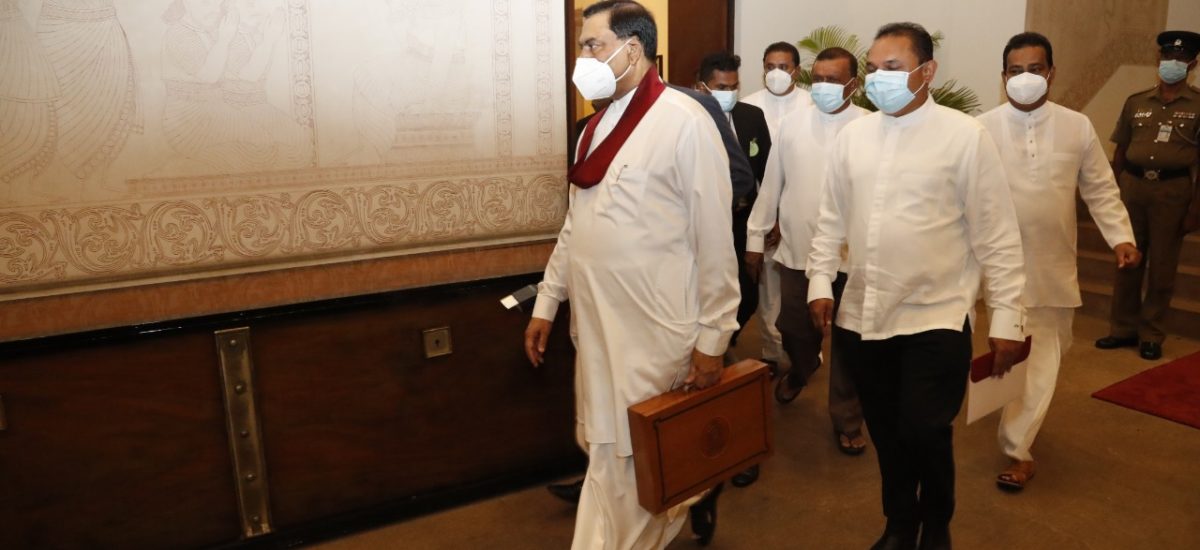Photo courtesy of NEWSWIRE
The second budget of President Gotabaya Rajapaksa’s government was presented on November 12 by his younger brother Finance Minister Basil Rajapaksa. Cheer leaders and image builders claim the budget is extra ordinarily beneficial and presented by a minister who is exceptionally clever.
But a budget that expects to grab Rs. 2,284 billion from us as revenue and spend Rs. 3,912 billion for us within 12 months leaving Rs. 1,628 billion as a debt for generations to pay cannot go unexamined.
Amid a myriad of internal and external challenges, President Rajapaksa marked a historic landslide victory in 2019 with 6.9million votes. After nine months, in testament to his leadership, the party won the 2020 Parliamentary Election with an overwhelming majority. It’s no secret that the government is at its lowest ebb of popularity within a period as short as two years.
The Finance Minister’s first task was to rebuild the lost image of his elder brother. The budget starts with a preface. It details out Rajapaksa family tree and parentage of the president saying “The Rajapaksas have a history of never being daunted bychallenges.” I am not sure whether the minister achieved his task or wasted his time and ours. Except for the ruling class, the majority of the 6.9 million people are on a highway protesting about some issue or the other. His second task was to live up to the image built up by his supporters. When he read out the budget speech, thumping on desks by backbenchers proved that this task was achieved. The third task was to justify the mistakes committed by the government rather than boasting of its achievements. The failed and ludicrous attempts to convert the agriculture from chemical to organic material within a single season, to control paddy purchasing and the rice selling price and the drama performed by Essential Service Commissioner together with Director General of Consumer Affairs Authority are only some of them. The government failed, the public lost and the fun remains.
The budget identifies issues, strengths and challenges. This is somewhat a SWOT (Strengths, Weaknesses, Opportunities, Threats) analysis. Social and economic disparities, slow progress of achieving Sustainable Development Goals, environmental catastrophes owing to the increased global temperature and limited assistance from bi-lateral and multi-lateral institutions are identified as major issues.
Among a series of strengths the minister’s two elder brothers are identified as great strengths. The budget goes on to say, “Our President embodies simplicity, and is a leader, who is honest, makes firm decisions, and is dedicated…is a great strength to our way forward” and “Hon. Prime Minister Mahinda Rajapaksa…is a leader who has rendered an extraordinary service to thisnation.”
Drug mafia, fraudulent business operations, forces detrimental to the country, common global challenges, rising cost of living, obsolete economic tools and foreign debt burden and state enterprises are mentioned as challenges.
The budget proposes improving business focus and financial discipline of State Owned Enterprises (SOEs). But proposed measures are not effective or adequate, touching only the surface. The BOI, EDB, and SLTDA have failed in improving investments, exports and tourism. These agencies pay high salaries and perks to staff, conduct road shows, fairs and conferences in foreign lands at extravagant costs. The import content of material and equipment used in construction and in export products is exorbitantly high, draining more foreign exchange than what they earn.
Some SOEs gobble a good chunk of public funds but suffer from managerial incompetency. They are created and maintained for prestige. Successive governments appointed business tycoons, owners and shareholders as chairpersons of SOEs. They run their own enterprises with record profits but they run SOEs with record losses. The secret is that while they own businesses, they do not manage them; their businesses are managed by efficient handpicked managers.
The budget is correct in saying that “Unproductive high expenditures and weaknesses in expenditure controls have resulted in oftengovernments not being able to properly engage in expenditure management”. But the budget has increased provisions for unproductive high expenditure such as Highways and Defence and reduced the fuel allocations to MPs by a mocking pittance. The budget allocates Rs. 280 billion for Colombo Port Access Expressway, New Kelani Bridge Athurugiriya Expressway, CentralExpressway, Kurunegala-Dambulla Expressway, Ruwanpura Expressway, Colombo-Moratuwa Marine Drive and flyovers in the city of Colombo and rural roads and bridges. This type of infrastructure bears a long gestation period. They will not improve the social and economic standards of the majority of people. Construction material, equipment, technology and even labor are imported, draining limited foreign exchange. Community participation and benefits will be marginal while the maintenance cost is extremely high and they hardly promote any economic activity.
The decision to issue quarterly warrants instead of the annual warrant to government entities is timely and effective. Most government institutions do not have a disbursement plan aligned to their mandate and objectives. During early part of the year capital expenditure is low and slow. The agencies accelerate spending haphazardly during the latter part to avoid under expenditure and audit queries. They make advance payments to other government entities to demonstrate higher disbursement. Quarterly warrants would keep agencies alert.
The minister laments about the inefficiency and overstaffing of the public sector. His solution to the inefficient over-burdened public sector is, “Steps will be taken to offer permanent appointments from January 2022 to over 53,000 graduates who are already recruited to the government service as trainees. It is expected that around Rs. 27,600 million will be necessary for this” and extension of the retirement age of public servants to 65 years.
New recruitment to public service, especially graduates, could be terminated. Instead the government can introduce a lucrative (employer-employee-government) contributory pension scheme for those employed outside the public sector.
The budget tries to revive the five hubs concept that has remained wishful thinking for over a decade. We talk of a knowledge hub but have failed to put our house in order. Instead of becoming a knowledge industry, education has become a money making industry with full of tuition shops. We talk of a shipping hub but international shipping lines complain of hundreds of thousands of small fishing boats crossing international naval routes. Sri Lanka is the best tea producing country in the world; Dubai does not grow a single tea bush but has established a tea hub while we are still dangling with the five hub concept.
To encourage the use of non-toxic weedicides and the production of organic fertilizer and to introduce new agro-technologies, the budget has allocated a total of Rs. 61,000 million. No implementation mechanism is identified. The budget is silent on how this money would be allocated – for whom, for what purpose, how much, how often and beneficiary selection. The scenario unfolded after the president declared that Sri Lanka was the first country in the world to achieve total organic farming. Whether the cash strapped government can afford to bear such a huge cost is questionable. The Sri Lankan farmer is already over subsidized and over dependent; more government assistance will push him further down his subsistence level while modernization and commercialization of farming will remain a distant dream.
The budget allocates Rs. 5,000 million to establish new industrial zones with land, electricity, water and access roads to accommodate SMEs. Most of the industrial estates and export promotion zones have ended up with losses due to dislocation, misidentification and mismanagement. The new proposal would add more estates to that list; providing mere infrastructure facilities would not address the woes of SMEs.
The budget says that at the time of drafting the Vistas of Prosperity and Splendor document, people requested rural schools with teachers of English, Science and Technological Studies and playgrounds, rural hospitals, sanitation facilities, rural roads, safe drinking water, rehabilitation of tanks and canal, electricity, telecommunication, technology, marketing and financing facilities and protection from wild elephants.
The Budget allocates funds for the rural sector as follows:
| Purpose | No | Amount (Rs. in Millions) |
| New water supply connections | 3,314,500 | 49,000 |
| Vari Saubhgya | — | 68,000 |
| Grama Niladari Divisons | 14,000 | 42,000 |
| Local Government Divisions | 4,917 | 20,000 |
| Decentralized Budget for MPs | 225 | 3,375 |
| Div. Secretary Divisions | 335 | 20,000 |
| Gama Samaga Pilisandara | — | 85,000 |
| Total | 284,003.375 |
The Finance Minister explains the objective of allocating such a colossal amount for rural development. “Our foremost objectiveis to strengthen the rural economy, raise the income level of rural families, liberate them from the subsistence mentality, integrate their economic activities to the mainstream, increase Gross Domestic Product and minimize the income disparity.”
While the intention is noble, it is not achievable within three to four years. There are innumerable constraints and bottlenecks in implementation of infrastructure development programs in rural sector. Capacity issues, unavailability of materials and equipment, lack of technical support and absence of contractors are only a few. The entire responsibility for the implementation and coordination of this program will fall on the Divisional Secretary (DS) who has become jack of all trades.
The budget allocates around Rs. 15,000 million to establish a mini supermarket network at the Grama Niladhari Division level while Trade Minister boasts about opening an additional 1,000 CWE shops. There is a well working supermarket structure run by the private enterprises. The government must encourage them to establish mini supermarkets in rural areas.
In brief, the budget carries a few pluses along with some strategic thoughts but there are more minuses and wishful thinking.
The suspension of constructing new public office building, pruning the president’s budget, conversion of the service economy to a producing economy, developing the inland fishery sector and strengthening the rural economy are among pluses. But some of them cannot be implemented, some are incomplete and inadequate, some are wishful thinking and some are damaging. The president’s budget is cut down but the Defence Minister’s budget is raised.
The private sector is treated as a source for tax revenue but not as an engine of growth. Funds allocated for the apparel industry, SMEs, tourism, school van operators, private bus operators, three wheelers, wedding and entertainment reflects the failure and the bankruptcy of the engine of growth.
The budget is a mirror effect of the inconsistency, incoherence and confusion that prevail at different levels of the government. The budget allocates billions of rupees for activities without feasibility. Fortunately it would remain only in the document as government is cash trapped and has no funds.


